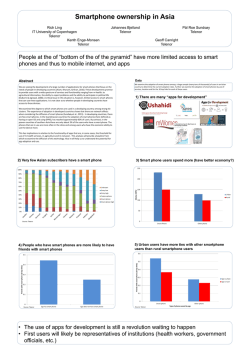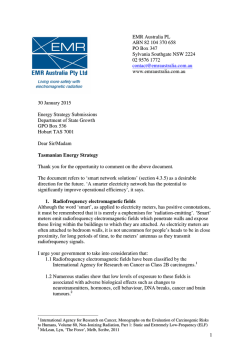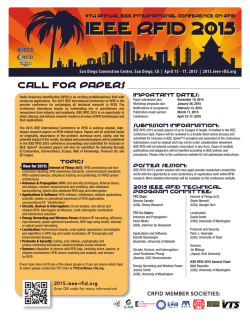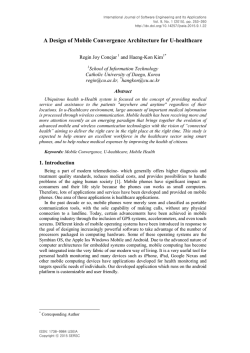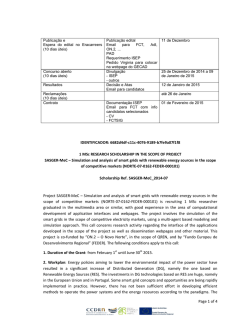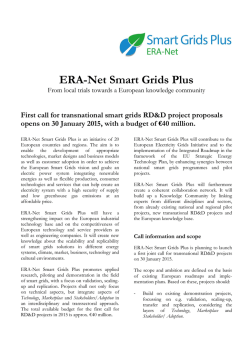
Lowest Prices - Cialis Preço 2012
KFUPM Smart Campus and the Role of RFID in Academia M.Wasim Raad Computer engineering department King Fahad University Petroleum Minerals Dhahran-Saudi Arabia Email: [email protected] Abstract Radio frequency identification (RFID) is revolutionizing the way organizations around the world track the location and movement of goods and assets. RFID technology utilizes inexpensive wireless RFID chips or tags that report their location to nearby scanners. Items with RFID tags can be tracked from a supplier’s factory floor to the retailer’s store shelves. In contrast, contactless smart cards utilize RFID technology for identifying people as well as for performing financial transactions. KFUPM is one of the few universities in the region to establish a smart campus for controlling access to its premises using RFID technology. KFUPM also established a new smart card & RFID lab to spread the RFID know how among its students and the community as well as offering consultancy to local industry. The paper gives introduction to RFID technology in addition to throwing light on the KFUPM smart campus. I- Introduction The World nowadays tends toward automating and computerizing the activities of daily life. Amongst the recent advanced technologies is smart card and RFID technology. Smart cards have been introduced to replace the traditional magnetic card. The smart card brings a variety of benefits to users. It provides security like encryption and electronic signatures, stores up to 100 or more times the information than a typical magnetic strip card, and reduces tampering and counterfeiting through high security mechanisms. Today, about 3 billion cards have been issued worldwide. In the last decade, smart cards evolved from basic memory cards to complex systems on chips with expanding processing power. This has opened the avenue to many applications such as financial transactions, e-commerce, physical access control, health, and transportation services [1]. The smart card, an intelligent token, is a credit card sized plastic card embedded with an integrated circuit chip. It provides not only memory capacity, but computational capability as well. A smart card usually consists of a ROM or flash memory, EEPROM and a CPU as shown in figure 1. Access to data stored on the card is under the control of the smart card operating system. The card operating system not only makes the smart card secure for access control, but can also store a private key for a public key infrastructure system. The self-containment of smart card makes it resistant to attack as it does not need to depend upon potentially vulnerable external resources. Because of this characteristic, smart cards are often used in several applications which require strong security protection and authentication [2]. In addition to information security, smart cards achieve greater physical security of services and equipments, because a smart card restricts access to all but authorized users. Furthermore, the smart card can be used as a credit/debit bank card which allows it to be used effectively in ecommerce applications. Smart cards greatly improve the convenience and security of any transaction. They provide tamper-proof storage of user and account identity. Smart cards also provide vital components of system security for the exchange of data throughout virtually any type of network. They protect against a full range of security threats, from careless storage of user passwords to sophisticated system hacks. Multifunction cards can also serve as network system access and store value and other data [3]. Most relevant applications of smart cards are: financial applications (E-purse, credit/debit), Government programs (Electronic benefit transfer), information security, physical access, health card, university identification, transportation, electronic ticketing and many others [4]. Figure 1. Smart Card Organization In terms of data storage, a smart card is organized in a hierarchical form through directories. Similar to MS-DOS, there is one master file (MF) which is like the root directory. Under the root, we can have different files which are called elementary files (EFs). We can also have various subdirectories called dedicated files (DFs). Every DF is dedicated for a separate application. Under each subdirectory will be elementary files again. The master file is implicitly selected after the smart card is reset. The elementary file (EF) simply consists of a header and the body which stores the data. The header of the file stores information about the file such as identification number, description, types, size, and so on, see figure2 and figure3. Particularly, it stores the attribute of the file which states the access conditions and current status. Access of the data in the file depends on whether those conditions can be fulfilled or not. However, in order to provide greater security control, the attribute of each file is enhanced by adding access conditions and file status fields in the file header. Moreover, file lock is also provided to prevent unauthorized access. This security mechanism provides a logical protection of the smart card [5, 6]. Among all smart cards, the MULTOS open platform smart card is considered one of the most secure smart cards, enabling anybody to program and download multiple applications securely on the same card even after issuing the card [5]. Figure2. Logical file structure of a smart card. example. Figure3. Sample implementation In contrast with smart cards as a general term, RFID in the simplest form, and as its name implies, radio frequency identification, is the process and physical infrastructure by which a unique identifier, within a predefined protocol definition, is transferred from a device to a reader via radio frequency waves. Imagine a world where a company has no problem finding inventory in a warehouse, or ensuring that products it ships concur with the shipping order, or determining that the products received are all in the shipment, or avoiding stock-outs on the sales floor, or simply finding assets on its premises. This is the promise of RFID- a technology that can enable these situations to happen. The simplest RFID system has three major components: • An RFID tag • An RFID reader • A predefined protocol format for the information transferred. The tag is composed of two essential elements and one optional component: • An integrated circuit • An antenna • Memory (optional) The integrated circuit contains a microprocessor, memory and a transponder. The microprocessor processes the information coming from the reader. Each tag contains a unique identifier that makes it different from every other tag in a specific set. The antenna is used to communicate with the reader [7]. Most smart cards use wireless radio frequency identification (RFID) technology for a contactless architecture aimed at reducing wear-and-tear on cards and equipment. Meanwhile, a few corporate pioneers are starting to combine data for physical and computer access control on a single smart card. An employee can present the same card to get past corporate security gates in the morning, and to log onto the computer network later that day. About 55,000 Microsoft Smart ID badges are of this kind [8]. Many applications are now using radio frequency (RF) chip technology to automatically identify objects or people. These applications range from tracking animals and tagging goods for inventory control to enabling fast payment and securely identifying people. While these applications all use radio waves to communicate information, the RF chip technology used for each is quite different, addressing the application’s unique storage, range of security requirements. As a general definition, radio frequency identification (RFID) tag technology is used in applications that identify or track objects and contactless smart card technology is used in applications that identify people or store financial or personal information. Figure 4 summarizes the types of technologies used in some key applications and the level of information protection that they provide. Figure4. Comparison of RFID Tag and contactless smart card technologies RFID tags are simple, low cost and disposable and are being used to identify animals, track goods logistically and replace printed bar codes at retailers. There is little to no security on the RFID tag. In contrast, contactless smart card technology is used in applications that need to protect personal information or deliver secure transactions. There are an increasing number of contactless smart card technology implementations that capitalize on its ability to enable fast, convenient transactions and its availability in form factors other than plastic cards- for example inside of a watch, key fob or document. Current and emerging applications using contactless smart card technology include transit fare payment cards, government and corporate identification cards, documents such as electronic passports and visas, and contactless financial payment cards [9]. II- The KFUPM Smart Campus Universities need simple identity cards for all employees and students who are granted access to certain data, equipment and departments according to their status. Multifunction, microprocessor based smart cards incorporate identity with access privileges and also stores value for use in various locations, such as cafeterias and stores. Numerous universities around the world are utilizing smart cards. The King Fahd University of Petroleum and Minerals (KFUPM) in Saudi Arabia is one of the first universities in the area to adopt a comprehensive multifunctional smart card system. The KFUPM Smart ID Card holds the first electronic purse in Saudi Arabia and is being used not only for electronic payment but also for access control as well as a means of identification throughout the campus. The smart card secures access to 28 buildings spread across 900 acres of university grounds. The KFUPM card system will provide the following functions: • Photo ID • Library borrowing privileges • Access control to university facilities • Electronic purse • Recreation center services • Medical center services • Logical access to PCs and the internet • E-learning Since the roll-out started in 2002, KFUPM has issued over 15,000 cards to students, staff and visitors including KFUPM alumni. All cards have a MIFARE contactless chip, including a digital fingerprint from the cardholder for verification of the cardholder’s identity and for access control to specific highly secured areas. The MIFARE contactless card allows up to 16 different applications to sit on the card. Some card types hold a contact chip as well in which the digital photograph is stored. In addition, the chip contains e-purse functionality for electronic payments to be used in cafeterias and restaurants throughout the campus. The cards are personalized such that the graphical personalization being done using desktop printers with integrated smart card readers. The cardholder’s photograph is printed on the card, of which one side is personalized in English and the other side contains the cardholder’s data in Arabic characters and Hindi numbers. Furthermore, the KFUPM Smart ID Card is also used for library applications and for use of the University’s medical centre. The new state of the art KFUPM smart ID card represents not only one of the most advanced University ID cards in the world, but also leads the way for national ID card projects in the region, as the design of the KFUPM system is far more than a typical University ID scheme. A full card management system, post-issuance personalization capability, using biometrics to access certain parts of the building and the capability to extend this scheme at any time, make this project a ground-breaking solution for the entire region. In adopting such a high-end smart card solution, KFUPM, the leading University in Saudi Arabia, has set the benchmark for ID solutions in the entire Middle East region. The contact chip used in the project caters for future plans, including an open electronic purse which could be used as means of payment all over the country. The current chip also allows the generation and download of digital certificates, securing electronic (data) communication. The complete smart card scheme is also prepared to support future applications like logical access control for computers and protected databases as well as electronic voting for student elections. Using the smart campus, the university can manage centrally the complete life-cycle of all cards and the on-card applications with potential Post-Issuance Personalization functionality. This means, the University is able to add, change and delete applications after the cards have been issued. The authorized administrators may apply for cards via a standard web browser, whereas changes in status of cards and their applications are automatically communicated to the relevant application providers. See figure5 for layout of the KFUPM Smart Card management system for the smart campus. Whenever a student or faculty is issued a new smart card, a unique ID is downloaded from the main server into the local controller of the particular labs or classrooms he has the privilege to access. Whenever the academic term ends, or the student graduates, these privileges are removed from the system. Figure5. The layout of the KFUPM Smart Card Management System The vision of KFUPM is to become a leading University in IT-empowered education, research, outreach, and administration. Adopting the smart card system with multiple applications is another milestone on this road. No doubt, this project enabled the University to become a centre of excellence around smart card implementations in the Kingdom [10]. III- The Role of RFID in Education in KFUPM The computer engineering department at KFUPM established a new Smart Card & RFID lab for innovative solutions in 2006. The objective of the lab is to train students in developing Innovative applications for the MULTOS smart card operating system being used in bank cards and national ID cards in Saudi Arabia, in addition to exploring and researching new challenging and emerging RFID solutions, and providing consultancy services to the local industry as part of the research institute in KFUPM. Computer engineering students are already familiar with the smart card & RFID technology, since this technology was taught to them as part of the final year digital system design course requirements for the last five years. The lab at King Fahad University of Petroleum & Minerals will aid local industry in supporting the national ID card program as well as projects in electronic payments and health care [11]. Equipped with state-of-the art smart card & RFID tools, including a MIFARE development system in addition to biometric SDKs, the new lab will provide an excellent facility to conduct projects as well as research in smart card & RFID. A number of student projects have been accomplished using the newly established lab, like design of a smart card prepaid electricity system, design of an RFID based system to prevent children accessing hazardous appliances at home, and an RFID based asset tracking system for smart warehouse in supply chain. Figure6 shows a layout of the RFID tracking smart ware house system project. A final year course on introduction to RFID technology has been introduced and taught for the last year. The main objectives of the course are the following: ¾ Presenting the most important recent advances in smart cards and RFID technology and research. ¾ Focusing on the most fruitful research and hot areas in these technologies. ¾ Underlying fundamental limitations of these technologies. ¾ Enabling Computer Engineering students to become pioneers in designing smart card & RFID systems. ¾ Exposing students to the cutting edge technology in the proposed area. Figure6. Layout of the RFID based Asset tracking system for the smart ware house project. IV- Conclusions and discussions This paper introduced smart card & RFID technology. It also highlighted important points in the KFUPM smart campus experience, in addition to giving glimpses on how KFUPM is starting to spread the know how of RFID technology in its educational system. KFUPM plays a very crucial role in presenting a success story in implementing RFID technology as an example for other universities and institutions in the region. Utilizing RFID technology in student projects and research in KFUPM has a big impact on a university which prepares future engineers to conduct RFID projects like the Saudi national ID project. However, there are existing challenges like cost and the lack of RFID tools and hardware in the local market, and the need to involve industry in funding these projects. Upon completion of the smart campus project, it is hoped that the KFUPM smart campus will be an ideal case study. V- Acknowledgements The author would like to acknowledge the support of KFUPM in writing this paper. VI- References [1] Jean-Francois Dhem and Nathalie Feyt, IEEE Micro, Vol:21, issue:6, Nov-Dec 2001, p.14-25. [2] Dirk Huseman, Concurrency IEEE, Vol7, issue2, April-June 1999, pp.24-27. [3] http://www.smartcardbasics.com/ [4] Henry Dreifus, J. Thomas Monk, Smart Cards: A guide to building and managing smart card applications, Wiley, 1997. [5] W. Ranki and W. Effing, Smart Card Handbook, John Wiley and Sons 2000. [6] Mike Hendry, Smart Card Secuirty and Applications, ARTECH HOUSE INC. 1997. [7] Jerry Banks, David Hanny, Manuel A. Pachano, Les G. Thompson, RFID Applied, John Wiley and Sons, 2007. [8] Jacqueline Emigh, ‘Getting Clever with Smart Cards’, Access Control & Security Systems, May 2004. [9] Smart Card Alliance white paper, ‘ RFID Tags and contactless Smart card technology: Comparing and contrasting Applications and capabilities’, www.smartcardalliance.com. [10] Biometric Tech Today, Vol 13, issue 10, Nov-Dec 2005. [11] Card technology, August 2006.
© Copyright 2025
